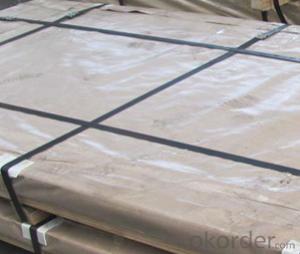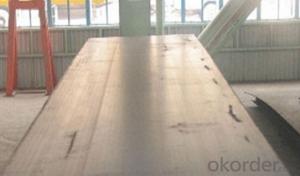Hot Rolled Carbon Steel Sheet G3136 CNBM
- Loading Port:
- Qingdao
- Payment Terms:
- TT OR LC
- Min Order Qty:
- 10 pc
- Supply Capability:
- 30 pc/month
OKorder Service Pledge
Quality Product, Order Online Tracking, Timely Delivery
OKorder Financial Service
Credit Rating, Credit Services, Credit Purchasing
You Might Also Like
Quick Details
| Standard: | AISI, ASTM, DIN, GB, JIS | Grade: | A572,A573,A633,A678,A709,A710,G3101,G3136,etc | Thickness: | 1mm-200mm |
| Brand Name: | SHOU GANG GROUP, AN STEEL | Model Number: | Q235 | ||
| Type: | Steel Plate | Technique: | Hot Rolled | Surface Treatment: | Coated |
| Application: | widely | Special Use: | High-strength Steel Plate | Width: | 1000mm-3000mm |
| Length: | 1000mm-12000mm | Price Term: | FOB CIF CFR |
Packaging & Delivery
| Packaging Details: | standard seaworthy export packing or as the request of customers |
| Delivery Detail: | 10 days after deposit or according to customers' quantity |
Specifications
hot rolled carbon steel sheet
1.Thickness:1mm-200mm
2.Length:1000mm-12000mm
3.Width:1000mm-2000mm
hot rolled carbon steel sheet
| Product | HR steel plate prices carbon steel plate prices per kg |
| MOQ | 25 ton |
| Thickness | 1mm-200mm |
| Width | 1000mm-3000mm |
| Length | 1000mm-12000mm |
| Application | widely |
| Standard | AISI,ASTM,BS,DIN,JIS,GB,etc |
| Grade | A572,A573,A633,A678,A709,A710,G3101,G3136,etc |
| Tpye | Steel plate |
| Surfacing | Coated |
| Productive Technology | Hot Rolled & Cold Rolled |
| Port | |
| Payment Terms | L/C,T/T,Western Union,MoneyGram |
| Product Ability | 5000 tons per month |
| Delivery | 10 days after deposit or according to customers' quantity |
| Packing | standard seaworthy export packing or as the request of customers |
- Q:What is the maximum width of a steel sheet?
- The maximum width of a steel sheet can vary depending on various factors such as the manufacturing process, equipment capabilities, and industry standards. In general, steel sheets can be produced in widths ranging from a few inches to several feet. However, in certain specialized applications, wider steel sheets exceeding 100 inches or more may be available. It is best to consult with steel manufacturers or suppliers to determine the maximum width options they offer, as it can vary depending on the specific requirements and capabilities of the production facility.
- Q:What is the difference between a self-color and painted steel sheet?
- A self-color steel sheet is one that has not undergone any additional surface treatment or coating, whereas a painted steel sheet has been coated with a layer of paint or another protective coating to enhance its appearance and provide added protection against corrosion or other environmental factors.
- Q:Is 5mm thick steel plate tapping M8 thread reliable?
- The pitch of the M8 is 1.25, it can attack 4 teeth. The force of the thread is 4-5 teeth. The bottom is not greater than 6.7mm, 8.8 plus elastic pad bolt.
- Q:Can steel sheets be used for electrical applications?
- Yes, steel sheets can be used for certain electrical applications. Steel sheets are often used as a magnetic core material in transformers and in electrical motors. However, for most other electrical applications, materials with better electrical conductivity, such as copper or aluminum, are preferred.
- Q:Are steel sheets suitable for agricultural applications?
- Yes, steel sheets are suitable for agricultural applications. Steel is a durable and versatile material that offers excellent strength and resistance to corrosion, making it ideal for various agricultural uses such as barns, sheds, fencing, and equipment storage.
- Q:What is the electromagnetic steel plate in the generator?
- The use of silicon steel sheet generator is designed to: 1) as magnetic pole and magnetic path with smaller excitation current can get larger magnetic field; 2) adding silicon steel material, increases the permeability and resistance to reduce eddy current losses in the steel sheet; 3) the steel sheet made of a film, increase the path of vortex flow, reduce the eddy current loss.
- Q:What are the different surface finishes available for steel sheets?
- There are several different surface finishes available for steel sheets, including hot rolled, cold rolled, galvanized, coated, and brushed finishes.
- Q:Are the steel sheets easy to transport and handle?
- Yes, steel sheets are relatively easy to transport and handle. They are typically compact and lightweight, making them convenient to move around. Additionally, their flat and rigid nature allows for easy stacking and loading onto transportation vehicles. However, larger and heavier steel sheets may require specialized equipment and machinery for safe handling and transportation.
- Q:What is the difference between coated and uncoated steel sheets?
- The primary distinction between coated and uncoated steel sheets lies in their protective layer and surface finish. Coated steel sheets, also referred to as galvanized steel sheets, possess a layer of zinc coating to prevent corrosion and enhance durability. This zinc coating serves as a sacrificial layer, shielding the underlying steel from rust and other forms of damage. Furthermore, coated steel sheets exhibit a more polished and smoother appearance. In contrast, uncoated steel sheets do not undergo any treatment involving a protective layer. Consequently, they are more prone to corrosion, particularly when exposed to moisture or chemicals. Uncoated steel sheets are commonly utilized in situations where corrosion resistance is not a significant concern, such as in construction projects where the steel will be covered or safeguarded in some manner. Regarding cost, coated steel sheets are generally pricier than uncoated steel sheets due to the additional manufacturing process required to apply the zinc coating. Nevertheless, the increased cost is justified by the improved durability and extended lifespan of coated steel sheets. To summarize, the key disparity between coated and uncoated steel sheets lies in the presence of a protective layer. Coated steel sheets offer superior corrosion resistance and possess a smoother appearance, while uncoated steel sheets are more susceptible to corrosion and possess a rougher surface finish.
- Q:What is the difference between a smooth and embossed steel sheet?
- A smooth steel sheet is characterized by its flat and uniform surface, lacking any textures or patterns. It is typically produced by rolling the steel through a series of rollers to achieve a sleek and even finish. Smooth steel sheets are commonly utilized in industries where a seamless and polished appearance is desired, such as in architectural and interior design, automotive manufacturing, and appliance production. On the other hand, an embossed steel sheet possesses a textured or patterned surface. This texture is created by pressing the steel sheet between embossing rollers, which imprint a design onto the surface. The embossed pattern can take various shapes, including diamonds, squares, or waves, and it adds a decorative and tactile element to the sheet. Embossed steel sheets are often employed in industries like furniture manufacturing, signage production, and decorative metalwork. In terms of functionality, smooth steel sheets are typically chosen for applications that require a clean and unadorned surface, such as for painting, coating, or other surface treatments. They serve as a blank canvas for further customization or finishing processes. In contrast, embossed steel sheets provide a visually appealing and distinctive texture that can enhance the aesthetic appeal of a product or structure without the need for additional surface treatments. Furthermore, the surface texture of a smooth steel sheet tends to be more resistant to fingerprints, smudges, and dirt accumulation compared to an embossed steel sheet. This makes smooth steel sheets easier to clean and maintain in applications where cleanliness is crucial, such as in the food processing or healthcare industries. Overall, the primary distinction between a smooth and embossed steel sheet lies in their appearance, functionality, and suitability for specific applications. While smooth steel sheets offer a clean, consistent, and versatile surface, embossed steel sheets provide a decorative and textured finish that can elevate the visual appeal of a product or structure.
1. Manufacturer Overview |
|
|---|---|
| Location | |
| Year Established | |
| Annual Output Value | |
| Main Markets | |
| Company Certifications | |
2. Manufacturer Certificates |
|
|---|---|
| a) Certification Name | |
| Range | |
| Reference | |
| Validity Period | |
3. Manufacturer Capability |
|
|---|---|
| a)Trade Capacity | |
| Nearest Port | |
| Export Percentage | |
| No.of Employees in Trade Department | |
| Language Spoken: | |
| b)Factory Information | |
| Factory Size: | |
| No. of Production Lines | |
| Contract Manufacturing | |
| Product Price Range | |
Send your message to us
Hot Rolled Carbon Steel Sheet G3136 CNBM
- Loading Port:
- Qingdao
- Payment Terms:
- TT OR LC
- Min Order Qty:
- 10 pc
- Supply Capability:
- 30 pc/month
OKorder Service Pledge
Quality Product, Order Online Tracking, Timely Delivery
OKorder Financial Service
Credit Rating, Credit Services, Credit Purchasing
Similar products
New products
Hot products
Related keywords





























